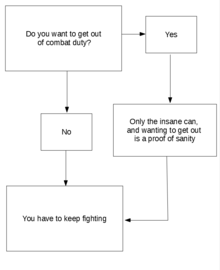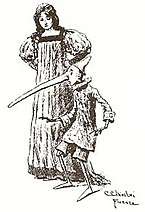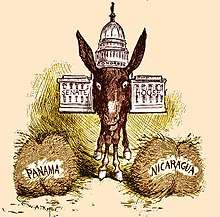Catch-22 (logic)
A catch-22 is a paradoxical situation from which an individual cannot escape because of contradictory rules or limitations.[1] The term was coined by Joseph Heller, who used it in his 1961 novel Catch-22.

An example is:
- In needing experience to get a job..."How can I get any experience until I get a job that gives me experience?" – Brantley Foster in The Secret of My Success.
Catch-22s often result from rules, regulations, or procedures that an individual is subject to, but has no control over, because to fight the rule is to accept it. Another example is a situation in which someone is in need of something that can only be had by not being in need of it (e.g.: the only way to qualify for a loan is to prove to the bank that you don't need a loan). One connotation of the term is that the creators of the "catch-22" situation have created arbitrary rules in order to justify and conceal their own abuse of power.
Origin and meaning
Joseph Heller coined the term in his 1961 novel Catch-22, which describes absurd bureaucratic constraints on soldiers in World War II. The term is introduced by the character Doc Daneeka, an army psychiatrist who invokes "Catch-22" to explain why any pilot requesting mental evaluation for insanity—hoping to be found not sane enough to fly and thereby escape dangerous missions—demonstrates his own sanity in creating the request and thus cannot be declared insane. This phrase also means a dilemma or difficult circumstance from which there is no escape because of mutually conflicting or dependent conditions.[2]
"You mean there's a catch?"
"Sure there's a catch," Doc Daneeka replied. "Catch-22. Anyone who wants to get out of combat duty isn't really crazy."
There was only one catch and that was Catch-22, which specified that a concern for one's own safety in the face of dangers that were real and immediate was the process of a rational mind. Orr was crazy and could be grounded. All he had to do was ask; and as soon as he did, he would no longer be crazy and would have to fly more missions. Orr would be crazy to fly more missions and sane if he didn't, but if he was sane, he had to fly them. If he flew them, he was crazy and didn't have to; but if he didn't want to, he was sane and had to. Yossarian was moved very deeply by the absolute simplicity of this clause of Catch-22 and let out a respectful whistle.
Different formulations of "Catch-22" appear throughout the novel. The term is applied to various loopholes and quirks of the military system, always with the implication that rules are inaccessible to and slanted against those lower in the hierarchy. In chapter 6, Yossarian (the protagonist) is told that Catch-22 requires him to do anything his commanding officer tells him to do, regardless of whether these orders contradict orders from the officer's superiors.[3]
In a final episode, Catch-22 is described to Yossarian by an old woman recounting an act of violence by soldiers:[4][5]
"Catch-22 says they have a right to do anything we can't stop them from doing."
"What the hell are you talking about?" Yossarian shouted at her in bewildered, furious protest. "How did you know it was Catch-22? Who the hell told you it was Catch-22?"
"The soldiers with the hard white hats and clubs. The girls were crying. 'Did we do anything wrong?' they said. The men said no and pushed them away out the door with the ends of their clubs. 'Then why are you chasing us out?' the girls said. 'Catch-22,' the men said. All they kept saying was 'Catch-22, Catch-22.' What does it mean, Catch-22? What is Catch-22?"
"Didn't they show it to you?" Yossarian demanded, stamping about in anger and distress. "Didn't you even make them read it?"
"They don't have to show us Catch-22," the old woman answered. "The law says they don't have to."
"What law says they don't have to?"
"Catch-22."
According to literature professor Ian Gregson, the old woman's narrative defines "Catch-22" more directly as the "brutal operation of power", stripping away the "bogus sophistication" of the earlier scenarios.[6]
Other appearances in the novel
Besides referring to an unsolvable logical dilemma, Catch-22 is invoked to explain or justify the military bureaucracy. For example, in the first chapter, it requires Yossarian to sign his name to letters that he censors while he is confined to a hospital bed. One clause mentioned in chapter 10 closes a loophole in promotions, which one private had been exploiting to reattain the attractive rank of Private First Class after any promotion. Through courts-martial for going AWOL, he would be busted in rank back to private, but Catch-22 limited the number of times he could do this before being sent to the stockade.
At another point in the book, a prostitute explains to Yossarian that she cannot marry him because he is crazy, and she will never marry a crazy man. She considers any man crazy who would marry a woman who is not a virgin. This closed logic loop clearly illustrated Catch-22 because by her logic, all men who refuse to marry her are sane and thus she would consider marriage; but as soon as a man agrees to marry her, he becomes crazy for wanting to marry a non-virgin, and is instantly rejected.
At one point, Captain Black attempts to press Milo into depriving Major Major of food as a consequence of not signing a loyalty oath that Major Major was never given an opportunity to sign in the first place. Captain Black asks Milo, "You're not against Catch-22, are you?"
In chapter 40, Catch-22 forces Colonels Korn and Cathcart to promote Yossarian to Major and ground him rather than simply sending him home. They fear that if they do not, others will refuse to fly, just as Yossarian did.
Significance of the number 22
Heller originally wanted to call the phrase (and hence, the book) by other numbers, but he and his publishers eventually settled on 22. The number has no particular significance; it was chosen more or less for euphony. The title was originally Catch-18, but Heller changed it after the popular Mila 18 was published a short time beforehand.[7][8]
Usage
The term "catch-22" has filtered into common usage in the English language. In a 1975 interview, Heller said the term would not translate well into other languages.[8]
James E. Combs and Dan D. Nimmo suggest that the idea of a "catch-22" has gained popular currency because so many people in modern society are exposed to frustrating bureaucratic logic. They write:
Everyone, then, who deals with organizations understands the bureaucratic logic of Catch-22. In high school or college, for example, students can participate in student government, a form of self-government and democracy that allows them to decide whatever they want, just so long as the principal or dean of students approves. This bogus democracy that can be overruled by arbitrary fiat is perhaps a citizen's first encounter with organizations that may profess 'open' and libertarian values, but in fact are closed and hierarchical systems. Catch-22 is an organizational assumption, an unwritten law of informal power that exempts the organization from responsibility and accountability, and puts the individual in the absurd position of being excepted for the convenience or unknown purposes of the organization.[5]
Along with George Orwell's "doublethink", "Catch-22" has become one of the best-recognized ways to describe the predicament of being trapped by contradictory rules.[9]
A significant type of definition of alternative medicine has been termed a catch-22. In a 1998 editorial co-authored by Marcia Angell, a former editor of the New England Journal of Medicine, argued that:
"It is time for the scientific community to stop giving alternative medicine a free ride. There cannot be two kinds of medicine – conventional and alternative. There is only medicine that has been adequately tested and medicine that has not, medicine that works and medicine that may or may not work. Once a treatment has been tested rigorously, it no longer matters whether it was considered alternative at the outset. If it is found to be reasonably safe and effective, it will be accepted. But assertions, speculation, and testimonials do not substitute for evidence. Alternative treatments should be subjected to scientific testing no less rigorous than that required for conventional treatments."[10]
This definition has been described by Robert L. Park as a logical catch-22 which ensures that any complementary and alternative medicine (CAM) method which is proven to work "would no longer be CAM, it would simply be medicine."[11]
Usage in scientific research
In research, Catch-22 reflects scientist's frustration with known unknowns, of which Quantum computing is a prime example: If two electrons are entangled such that if a measurement identifies the first electron in one position around the circle, the other must occupy a position directly across the circle from it, (a relationship that holds when they are beside each other and when they're light-years apart). The Catch-22 of quantum computing is that quantum features only work when they're not being observed, so observing a quantum computer to check if it's exploiting quantum behaviour will destroy the quantum behaviour being checked.[12] Heisenberg’s uncertainty principle prevents us from knowing a particle’s position and momentum simultaneously — if you measure one property, you destroy information about the other.
EC General Data Protection Regulation: The EU's expansive privacy regulation places limitations on artificial intelligence development, which relies heavily on (big) data.[13] Beyond its restrictions on the collection of user data, GDPR ensures that even if a company does collect personal data, its use for automated decision-making—a standard AI application—is limited. Article 22 mandates that a user can opt out of automated processing, in which case the company must provide a human-reviewed alternative that obeys the user’s wishes. When automation is used, it must be clearly explained to the user, and its application could still be punished for ambiguity or violating other regulations, making the use of AI a Catch-22 for GDPR-compliant bodies.
Artificial Intelligence: As indicated above AI depends on vast quantities of verified data, most of which is rightly considered private for personal or commercial reasons. This leads to a catch-22 resulting from inadvertent entry of seemingly innocuous or protected data to otherwise secure websites. Thus using dozens of "right of access" requests, Oxford-based researcher James Pavur found that he could access personal information—ranging from purchase histories, to credit card digits, to past and present home addresses—from several UK and US-based companies without even verifying his identity. In commercial fields various ploys to accumulate data useful for AI are ubiquitous. Access to high-quality training data is critical for startups that use machine learning as the core technology of their business. According to Moritz Mueller-Freitag, "While many algorithms and software tools are open sourced and shared across the research community, good datasets are usually proprietary and hard to build. Owning a large, domain-specific dataset can therefore become a significant source of competitive advantage."[14] User input even includes such innocuous user interfaces that encourage users to correct errors, such as Mapillary and reCAPTCHA. Thus the web user is groomed progressively to cooperate in the construction of AI in exchange for access to unverifiable information, whilst his rights are extinguished by agreeing to unfathomable terms and conditions.
The problem of unknown unknowns: This is a kind of inverse Catch-22 situation, in which Joseph Heller's Yossarian doesn't know yet that the bomber he was afraid to crew this evening was shot down last night. A similar deficiency explains why scientists haven't come up with a cure for Alzheimer's disease; — they don't know exactly what it is.[15] They can see what happens to patients and predict what will happen but don't understand its ultimate causes, why it affects the people it does, or why the symptoms grow worse over time.
Logic
The archetypal catch-22, as formulated by Heller, involves the case of John Yossarian, a U.S. Army Air Forces bombardier, who wishes to be grounded from combat flight. This will only happen if he is evaluated by the squadron's flight surgeon and found "unfit to fly". "Unfit" would be any pilot who is willing to fly such dangerous missions, as one would have to be mad to volunteer for possible death. However, to be evaluated, he must request the evaluation, an act that is considered sufficient proof for being declared sane. These conditions make it impossible to be declared "unfit".
The "Catch-22" is that "anyone who wants to get out of combat duty isn't really crazy".[16] Hence, pilots who request a mental fitness evaluation are sane, and therefore must fly in combat. At the same time, if an evaluation is not requested by the pilot, he will never receive one and thus can never be found insane, meaning he must also fly in combat.
Therefore, Catch-22 ensures that no pilot can ever be grounded for being insane even if he is.
A logical formulation of this situation is:
| 1. | For a person to be excused from flying (E) on the grounds of insanity, he must both be insane (I) and have requested an evaluation (R). | (premise) | |
| 2. | An insane person (I) does not request an evaluation (¬R) because he does not realize he is insane. | (premise) | |
| 3. | Either a person is not insane (¬I) or does not request an evaluation (¬R). | (2. and material implication) | |
| 4. | No person can be both insane (I) and request an evaluation (R). | (3. and De Morgan's laws) | |
| 5. | Therefore, no person can be excused from flying (¬E) because no person can be both insane and have requested an evaluation. | (4., 1. and modus tollens) |
The philosopher Laurence Goldstein argues that the "airman's dilemma" is logically not even a condition that is true under no circumstances; it is a "vacuous biconditional" that is ultimately meaningless. Goldstein writes:[17]
The catch is this: what looks like a statement of the conditions under which an airman can be excused flying dangerous missions reduces not to the statement
- (i) 'An airman can be excused flying dangerous missions if and only if Cont' (where 'Cont' is a contradiction)
(which could be a mean way of disguising an unpleasant truth), but to the worthlessly empty announcement
- (ii) 'An airman can be excused flying dangerous missions if and only if it is not the case that an airman can be excused flying dangerous missions'
If the catch were (i), that would not be so bad—an airman would at least be able to discover that under no circumstances could he avoid combat duty. But Catch-22 is worse—a welter of words that amounts to nothing; it is without content, it conveys no information at all.
See also
- Begging the question
- Cornelian dilemma
- Deadlock
- Double bind
- False dilemma
- Feedback loop
- Hobson's choice – taking what is offered or taking nothing
- Ironic process theory
- Kobayashi Maru – a choice presented in Star Trek
- "The Lady, or the Tiger?" – a no-win situation
- List of paradoxes
- Morton's fork
- Mu
- Ninety-ninety rule
- No-win situation
- Pyrrhic victory
- Social trap
- Strange loop
- Vicious circle
- Zugzwang
References
- Largest Idioms Dictionary, The Idioms. "Catch 22 meaning". Theidioms.com. Retrieved 12 May 2020.
- Beidler, Philip D. (1995). Scriptures for a Generation: What We Were Reading in the '60s. p. 162. ISBN 978-0820317878.
It is Catch-22: Dr. Daneeka explains how anybody who is crazy has a right to ask to be removed from combat status but how anybody who asks is revealing a rational concern for his own safety that makes him not crazy;
- Margot A. Henriksen, Dr. Strangelove's America: Society and Culture in the Atomic Age; University of California Press, 1997; ISBN 0-520-08310-5; p. 250.
- "Joseph Heller", Gale Encyclopedia of Biography, accessed via Answers.com, 16 August 2013.
- James E. Combs & Dan D. Nimmo, The Comedy of Democracy; Westport, CT: Praeger (Greenwood Publishing Group), 1996; ISBN 0-275-94979-6; p. 152.
- Ian Gregson, Character and Satire in Post War Fiction; London: Continuum, 2006; ISBN 9781441130006; p. 38.
- Aldridge, John W. (1986-10-26). "The Loony Horror of it All – 'Catch-22' Turns 25". The New York Times. p. Section 7, Page 3, Column 1. Retrieved 2011-01-09.
- "A classic by any other name", The Telegraph, 18 November 2007.
- Richard King, "22 Going on 50: Half a century later, the world is full of Catch-22s"; The Smart Set, 20 July 2011.
- Angell, M.; et al. (1998). "Alternative medicine--The risks of untested and unregulated remedies". New England Journal of Medicine. 339 (12): 839–41. CiteSeerX 10.1.1.694.9581. doi:10.1056/NEJM199809173391210. PMID 9738094.CS1 maint: ref=harv (link)
- Park, Robert L., Alternative Medicine: The Clinton Commission's Catch-22. Archived 2016-03-04 at the Wayback Machine
- Ornes, Stephen (2 June 2016). "Computing's search for the best Quantum questions". Quanta Magazine.
- Porubcin, Emilia (23 August 2019). "Catch-22 developing AI under GDPR". ICDS.ee.
- Muller-Freitag, Moritz (10 June 2016). "10 Data Acquisition Strategies for Startups". KDnuggets. Retrieved 16 October 2019.
- Shurkin, Joel (1 April 2015). "Catch-22 Alzheimers diagnoses and treatments". Inside Science.
- Heller, Joseph (1999). Catch-22: A Novel. Simon and Schuster. p. 52. ISBN 978-0-684-86513-3. Retrieved 2011-01-09.
isbn:9780684865133.
- Goldstein, Laurence (2004). "The Barber, Russell's paradox, catch-22, God, contradiction and more: A defence of a Wittgensteinian conception of contradiction". In Priest, Graham; Beall, J. C.; Armour-Garb, Bradley (eds.). The law of non-contradiction: new philosophical essays. Oxford University Press.


